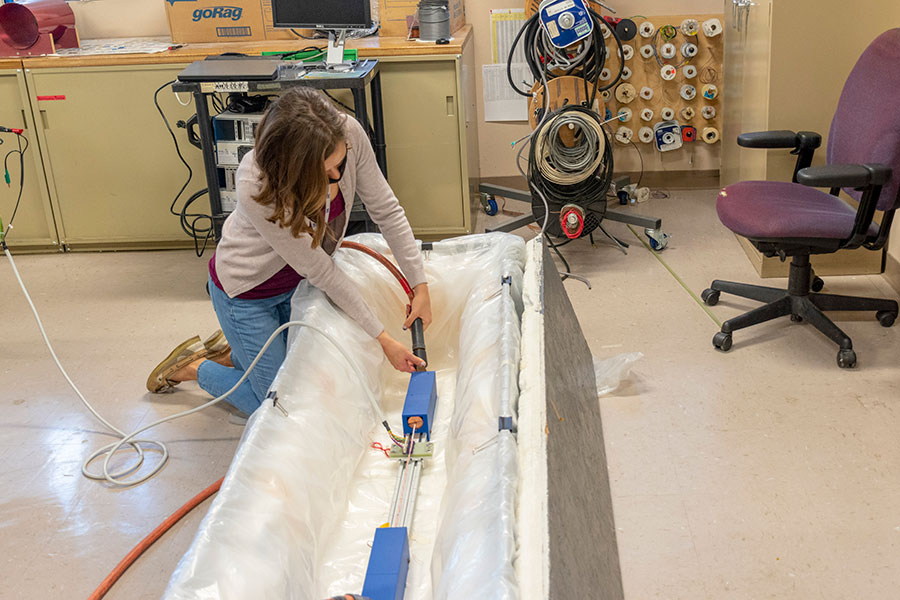
A FAMU-FSU College of Engineering doctoral student has earned a prestigious fellowship from the U.S. Department of Energy (DOE).
Virginia Phifer was one of 52 graduate students nationwide selected for the DOE’s Office of Science Graduate Student Research (SCGSR) Program.
The SCGSR program provides supplemental funds for graduate students to conduct part of their thesis research at a DOE laboratory within a defined award period, which ranges from three to 12 consecutive months. Phifer will complete her fellowship at the Lawrence Berkeley National Laboratory in Berkeley, California, beginning in January.
While at the Lawrence Berkeley National Laboratory, Phifer will be working on superconductor performance technology alongside scientist Maxim Marchevsky. To determine if currents are rearranging within a cable, Phifer will use a technique developed by Marchevsky that uses tiny sensors to detect a change in the magnetic field when currents in the cable start to redistribute and produces a voltage spike.
“This fellowship gives me the opportunity to partake in mentorship and collaborative research that corresponds to my thesis,” Phifer said. “I’ll also get to work with scientist Maxim Marchevsky, which will be beneficial because he developed the technique that I’ve adapted to my research and has a lot of expertise to help guide me.”
Phifer studies superconductivity, a phenomenon where a charge moves through a material without resistance. She currently conducts her research at the FSU-headquartered National High Magnetic Field Laboratory’s Applied Superconductivity Center.
Superconductivity happens when a material is cooled below a certain temperature using either liquid helium or nitrogen and operates below a certain magnetic field, causing no electrical resistance. Any material exhibiting these properties is called a superconductor.
“Think of it analogously to friction: if you run and slide on a carpet wearing socks, there’s a lot of friction and resistance and your socks will heat up,” Phifer said. “But if you run and slide in socks on a tile floor, there’s less resistance, so you won’t get that heat and you’ll slide further. In a normal conductor, you have resistance that causes the wire to get warm, but in a superconductor, you don’t have that resistance.”

There are different types of superconductors, but Phifer primarily works with one called Rare Earth Barium Copper Oxide (REBCO). Manufactured in the form of a flat tape, REBCO can carry a significant amount of current and operate at very high magnetic fields and temperatures.
Despite REBCO’s promising qualities, the way it’s manufactured causes defects that limit the amount of current it can carry. These glitches create hot spots that can burn a hole in a magnet. To avoid this issue, Phifer is trying to see if the current can be redistributed.
“I’m looking at these cables to see if the current actually does redistribute and how well, and if it does redistribute, how many of these bad spots can you have for the cable to still operate within limits and not cause issues,” Phifer said.
The goal of Phifer’s research is to understand what exactly is happening inside REBCO cables when bad spots occur and cause current redistribution. Being able to use these spots would render previously “bad” cables as usable through current redistribution, significantly lowering the price of REBCO cables.
Niobium titanium currently dominates the superconductor market, but the magnetic field of this conductor has reached its limit. REBCO conductor cables have the potential to replace niobium titanium, but for that to happen, researchers need to figure out a way to find the bad spots and redistribute the current.
“This technology can positively impact the environment because it uses very low power to operate the conductors,” Phifer said. “NASA and other companies are exploring the possibility of using REBCO cables for aircraft, because batteries and traditional copper wires are too heavy for an all-electric aircraft. Preserving our planet is important to me, so the green aspect of this is a big driver.”
The goal of the SCGSR is to prepare graduate students for science, technology, engineering or mathematics (STEM) careers important to the DOE Office of Science mission by providing thesis research opportunities through extended residency at DOE national laboratories. The research projects are expected to advance the graduate awardees’ overall doctoral research and training while providing access to the expertise, resources and capabilities only available at the DOE laboratories.
To learn more about the DOE Office of Science Research Fellowship Program or similar awards, contact the Office of Graduate Fellowships & Awards. For more information about the FAMU-FSU College of Engineering, visit eng.famu.fsu.edu. To learn more about the SCGSR, visit science.osti.gov.




